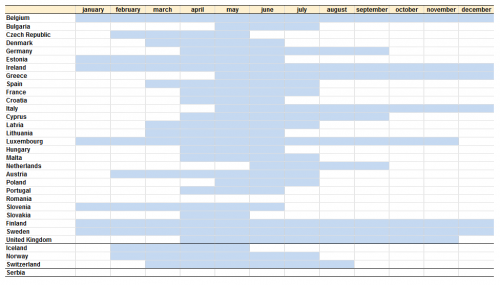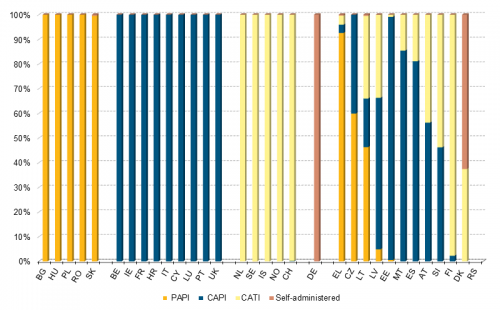Archive:EU statistics on income and living conditions (EU-SILC) methodology – data collection
This article has been archived.
This article is part of the Eurostat online publication EU statistics on income and living conditions (EU-SILC) methodology.
EU-SILC data are collected by National Statistical Institutes and could come from different sources. In some participant countries at the time of EU-SILC implementation a new survey was launched with cross-sectional and longitudinal elements. In other countries a combination of registers and surveys is used, that is data for the same respondents are collected partly by interview and partly from register. This article describes the main characteristics of the EU-SILC data collection. Firstly survey implementation is presented, then fieldwork periods, modes of data collection and finally interview duration.
Full article
EU-SILC implementation
In a number of European countries, national surveys on income and living conditions existed before the 1990s when the first EU-scale survey — the European Community Household Panel (ECHP) —was launched. The ECHP ran from 1994 to 2001 in fourteen of the then fifteen Member States (the exception being Sweden). Despite a high level of overall harmonisation in most countries, the ECHP suffered from some comparability and timeliness issues. It was with the triple aim of solving the ECHP’s technical problems, conforming to the internationally agreed definition of income and extending the data collection to the enlarged EU (and beyond) that the decision was taken to stop the ECHP and launch EU-SILC. After starting on the basis of a gentlemen’s agreement in 2003 in seven countries (six EU countries plus Norway; see Table 1), the EU-SILC project was then implemented by means of a legal basis which was gradually adopted as from 2003 and implemented from 2004 onwards.
Fieldwork periods
National surveys differ in terms of the period of time during which the fieldwork is carried out. The Commission Regulation 1981/2003 on fieldwork aspects and imputation procedures recommends that the one-shot survey fieldwork should extend over less than four consecutive months and the lag between income reference period and fieldwork is limited to eight months. When continuous surveys are used, the sample allocation over time should be monitored and the weighting adapted to produce unbiased estimates of the annual average. In 2013 most countries adopted a survey in which the fieldwork was concentrated in a period of a few months, mainly in the first half of the year, although there were some notable exceptions (Table 2):
- Belgium, Finland, Ireland and Sweden conducted EU-SILC throughout the year;
- in Greece, Italy, the Netherlands and the United Kingdom the fieldwork was carried out mostly in the second half of the year.
The impact of different fieldwork periods might have a noticeable impact over time when comparing indicators that show a steady and seasonal pattern, but the impact as regards analysis of permanent income distribution is likely to be negligible. The one-shot surveys always use the previous calendar year as the income reference period, whereas a sliding reference period is used for the continuous survey. Two countries, Ireland and the United Kingdom, use a sliding reference period for income and taxes on income and social insurance contributions. In Ireland it refers to the 12 months prior to the interview date. As for the United Kingdom, it is centred on the interview date. In addition, the respondents are asked to provide figures which relate most commonly to their current (and usual) incomes, i.e. which could relate to the last week, two weeks, or month. These figures are then annualised.
The greater degree of inconsistency between income related variables and socio-economic related variables when the fieldwork period is distant in time from the income reference period can be identified as a weakness in some instances of EU-SILC implementation.
Mode of data collection
Information needed for EU-SILC can be extracted either from registers or collected from interviews. As for the interviews, there are four different ways to collect the data: Paper-Assisted Personal Interview (PAPI), Computer-Assisted Personal Interview (CAPI), Computer-Assisted Telephone Interview (CATI) and Self-administrated questionnaire. Figure 1 shows the different modes of data collection used by the countries for the 2013 EU-SILC cross-sectional operation. Figures are obtained adding up the number of interviews carried out by each mode of data collection by each country and dividing it by the total of the interviews carried out in each country. Only face-to-face interviews are taken into account.
Twenty out of thirty one countries prefer using a single mode of data collection. Among them five use PAPI, nine CAPI, five countries use CATI and one Self-administered questionnaires. The remaining countries work with a mixed mode of data collection which means that two or more forms of collection are applied at the same time.
Interview duration
The EU-SILC Framework Regulation states that the total duration of the interview has not to exceed one hour on average. The Table 3 presents for the 2013 EU-SILC cross-sectional operation the mean interview duration in minutes calculated as the sum of the durations of all interviews at household or personal level, divided by the number of household members aged 16 and over whose household questionnaire is completed and accepted for the database. If the household interview duration or one personal interview duration is missing for one member of the household, then the household is excluded from the calculation.
For all countries the average interview duration in 2013 was below 60 minutes. The lowest average duration was found in the Netherlands (16.8 min.), and Spain (around 16.4 min.), while the highest value was in Germany (56.9 min.) followed by the United Kingdom (51.6 min.).
Direct access to
- EU statistics on income and living conditions (EU-SILC) methodology (overview of all articles)
- Income and living conditions (ilc) (ESMS metadata file — ilc_esms)
- Methodological guidelines and description of EU-SILC target variables



